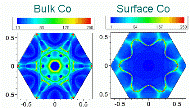Department of Physics and Astronomy: Publications and Other Research

Gordon Gallup Publications
Document Type
Article
Date of this Version
July 1980
Abstract
Energy curves for the ground state and the first seven excited states of ArH have been calculated using the multiconfiguration valence bond (MCVB) method. Important features of the excited curves include two distinct avoided crossings between the lowest Ar*H and the highest ArH* potential energy curves. Using these curves we have made a theoretical analysis of quenching of metastable Ar by collision with H at room temperature. Application of the Massey criterion indicates that the separation of the potential curves in the region of the crossing and the acceleration produced by the fall of the reactant channel potential curve from its asymptotic level combine to produce a relatively high probability for curve switching. A more quantitative estimate of the curve switching probability is given with the Landau–Zener formula and leads to a theoretical value of the quenching rate approximately ten times the experimental. In light of the many approximations involved this qualitative agreement is satisfactory and provides a rationale to explain the anomalously high rate constant for the quenching reaction. Structural features of the interacting potential curves are discussed in terms of the diabatic states involved. The Journal of Chemical Physics is copyrighted by The American Institute of Physics.


Comments
Published by American Institute of Physics. J. Chemical Physics 73, 894 (1980). ©1980 American Institute of Physics. Permission to use. http://jcp.aip.org/.